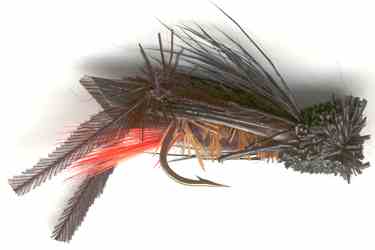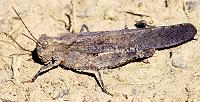Black Hopper Dry Fly
Black Grasshoppers and locusts can be imitated using this black hopper dry fly pattern. It represents a big meal to rainbow and brown trout. When flyfishing the fly should be fished on the surface and twitched to represent the struggling natural insect.

GRASS HOPPER AND CRICKET FLY PATTERNS. Hook size 12 - $US each
If the water you are fishing is near any farmer's fields than make sure you have some grasshopper imitation fly patterns in your fly box. Big trout love them. These very silly insects do not look before they leap and many end up landing in water. They wriggle in an effort to stay afloat not knowing that this movement is attracting the attention of large predatory trout. Compared with most aquatic insects a floating drowning grasshopper is a substantial meal to most fish. It is worth their effort to rise from the bottom and snatch a snack.
Ideally you will be fishing very early in the morning and late in the evening to catch the hatches. Sometimes you may only be able to have free time to go fishing in the middle of the day because of work or family commitments so this reduces your options of flies that work. If it is a warm sunny day many fish seek the deeper parts of the water system to stay cool. They will not come to the surface to investigate your normal offering of epoxy emereger buzzers or wet flies. It has to be something special to get them moving. That is what the Hopper fly is all about. It is a special fly, A big fly to grab a Rainbow or Brown Trout's attention. Float it on the surface and give the line a sharp pull every now and then to imitate the natural grass hopper trying to struggle. If you fish in the mountains I have found grasshoppers love alpine meadows. Mountain lake fish look for them as a regular food source. What follows is a question I asked on my Social Media page and the answers I recieved.

QUESTION TIME - READ THE WATER
What follows is a question I asked on my Social Media page and the answers I
received. The question posed was;- You have hiked up to the top of the mountain to fish this high altitude lake. What flies would you choose? There is no hatch about to happen. It is 11am. The sun has started to heat the mountain top. Clue = Wind.
READER'S ANSWERS
What time of year? and I assume Brown trout?.. However if its high up it won't be rocket science and they will be looking up for terrestrials so a couple of hoppers spaced out fished 10 secs dry then retrieved and cover the water and drop offs
READER'S ANSWERS
I would start with big bright dry flies,
including hoppers decreasing in size with a nymph dropped off of that after a few dry fly casts. Nothing? maybe small streamers. I am assuming over 6,000 ft
READER'S ANSWERS
In Colorado high mountain means probably above 10,000 feet. If the lake has some willows or other flora on its banks the wind could be blowing the bugs into the water
like ants and grasshoppers. I have seen the fish key in on ants right up against the bank. Problem is sun is getting high driving the fish into deeper water for cover. Have a little scotch, some lunch and watch for riseforms and what that represents.
READER'S ANSWERS
I fished mountain lakes in B.C. for 20+ years. Prince nymph 12-18 best for me and small Tom thumb's or humpy patterns for on top. If you fish from a boat or tube , I have also seen this strange phenom when the wind whips up and creates up drafts and you can be in the middle of the lake and it starts raining pine needles and BUGS. This is match the hatch time at it's best.
Use ant, beetle and hopper flies.
READER'S ANSWERS
Even though I am not an enthusiast about personally fishing high mountain lakes, there are hundreds within a 2 to 3 hour drive from here in Calgary that I could fish. I’m just lazy. There are also just as many lakes and rivers around here that require far less effort to get to. Also tramping around alone in the bush is not really the safest thing to do here in either Alberta or British Columbia. Too many very unfriendly bears and mountain lions in this area for my liking to justify fishing lakes with smaller fish and a lot of effort needed to hike through the bush to get to
Aside from that, reading the water of any lake or river requires some basic principles that apply to all. Prior to heading off to fish anywhere, a little knowledge is needed about the local terrain and season as to where you plan to fish. High mountain lakes have a very short season and generally have poor nutrient sources. After turn over, plant life, thus insects and then thus size of fish have little time to develop. My selection of flies that I would take to any high mountain lake would take that into account. Smaller is better. Nymphs and bottom dwellers plus a few small streamers or leach/scud patterns more than terrestrials and dry flies. Caddis fly hatches and adult life spans last over a long period than Mayfly’s. Reading the water involves understating your prey’s environment, source of food and life cycle. Something that can be researched long before setting off on a fishing trip.
Once at a lake or river, I like to spend at least a half an hour just observing before I start any fishing. With a high mountain lake, unless I’ve packed in a float tube, most likely I’m going to be casting from shore using a 4 wt or less. During my explore time I look for the best shore spots, test the water with a small net to find out what bugs are swimming below and what I can shake off plants and bush along the shore. That will mainly determine what flies I use. By 11:00 AM the sunlight’s angle of entry into the water is starting to be a factor so any wind that would chop up the water would be helpful. Wind would also blow in a few terrestrials. Without the wind I would be definitely fishing deeper. With the water heating, it will also mean nymphs and emergers will become more active. Usually the smaller, younger fish, even in lakes, take the biggest risks so they are the ones that will go after the dry flies including hopper and ants while the bigger fish are more likely to stay deep and feed from the bottom. The reason I will fish nymphs more often than dry’s unless I see a full bore hatch occurring.
Fly selection I would take with me would include San Juan worms, numerous nymphs (mostly caddis in this area) & scuds as to colour (I tie a number of white patterns and carry marking pens with me) in the size 14 to 20 (I particularly like to fish Prince’s so I carry a number of them), a selection of size 12 to 18 streamers and leaches, a number of midge patterns (wet & dry), a few ants, hoppers and beetles, and a few tried and true size 12 to 16 dry flies (Adams, Adams parachute, BWO’s, Elk hair Caddis, March Brown, Tom Thumb, Green & Brown Drakes, Irresistible, Royal Coachman). I try to always carry at least 3 of each fly. If I’m going to expend the energy to hike into a high mountain lake, I’m going to make sure I take a good supply of the most likely flies I will need as it is not so easy to walk back to the car for more.

